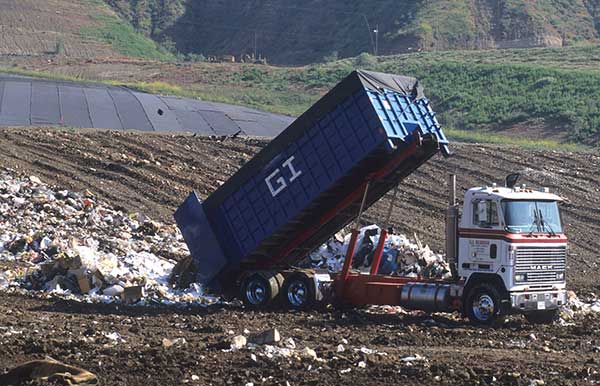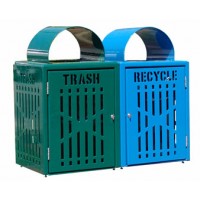 Landfills are growing faster than expected and one solution is to add more recycling receptacles in public spaces to reduce trash
Landfills are growing faster than expected and one solution is to add more recycling receptacles in public spaces to reduce trash
Everyone is looking for a simple solution to reduce the accumulation of waste, and recycling receptacles might be the easiest answer.
Reducing landfills is becoming a growing challenge for cities across the United States, as garbage dumps grow and environmental concerns mount for residents and city planners alike.
Municipalities must act. Waste is heading for the local dump at a pace faster than analysts predicted.
As a case in point, the US Environmental Protection Agency (EPA) estimated that 122 million tons of waste would be deposited in landfills in 2012. However, studies revealed that 262 million tons of trash wound up in landfills - an increase of 115% over the EPA estimate.
Clearly, waste control should be a major priority for city planners and concerned residents alike. Incorporating recycling receptacles into public spaces is a major way that cities can offer alternate trash disposal to the public, while actively reducing landfill growth.
Case study: City adds recycling receptacles to reduce waste
One city that has embraced a more 'green' approach to waste management by incorporating recycling receptacles is Cleveland, OH. This Midwestern city was concerned with increasing the access and visibility of the current recycling program, and installed 70 recycling receptacles throughout the downtown area to support this initiative.
The Office of Sustainability in Cleveland reported an early win, with 42 tons of recyclables collected in a matter of months. These water bottles, plastic bags, and bits of paper, plus more would no doubt have ended up in the trash can on the corner and eventually the landfill - if it weren't for the strategically placed recycling receptacles.
Cleveland's commitment to recycling and desire to raise awareness by making recycling receptacles accessible to the public is a model worthy of imitation for cities large and small throughout the United States.
Through proactive planning and a commitment to incorporating green practices, Cleveland has made a significant change in the visibility and importance of recycling within the city limits. The payoff is a more responsible way of dealing with waste that will conserve landfill capacity, reduce greenhouse gases, and promote a greener standard of living among residents and visitors.
Americans recycle as a way to reduce landfills
Recycling as a way of life is on the rise in the United States, and the reasons motivating this behavior were highlighted in a recent survey.
When asked about their motivation for using a recycling receptacle over a trash can whenever possible, 51% of respondents cited reducing landfill waste as the number one factor for recycling. The secondary reason was to conserve Earth's resources, with 43% of the respondents attributing this factor as their motivation.
It's obvious that controlling the sprawl of landfills is a concern on the minds of many Americans.
By working along with this awareness, city managers can reduce the amount of waste collected and increase the quantity of recyclables by making recycling receptacles available in parks, city centers, and along sidewalks.
Side-by-side trash receptacles and recycling receptacles are a great way to encourage people to make the right choice when discarding an item.
As the amount of trash headed for landfills increases, so too will the need to devote land and resources to maintaining these garbage heaps.
This is obviously not the most sustainable or aesthetically-pleasing use of one of our land, one of the most finite resources available today.
It is important to also consider the fact that the average landfill in the US will reach capacity in 33 years - but this timeframe is likely shorter due to the increase in the amount of waste disposed of each year. When landfills reach capacity, cities will face a new strategic problem in dealing with solid waste.
By encouraging the practice of recycling through the strategic use of recycling receptacles, cities can partner with concerned citizens to keep recyclable material out of landfills and conserve available space.
Recycle - reduce Greenhouse Gases
Recycling also provides another important benefit: reducing greenhouse gas emissions. People often think about the impact of motor vehicles, power plants, and manufacturing on greenhouse gases, but landfills are a major contributor towards these harmful gases.
As mentioned earlier, landfills are filling up at a rate faster than anticipated, and all this trash means more gas.
Landfills produce methane, a greenhouse gas that traps heat in the atmosphere at a rate 25 times greater than carbon dioxide. Researchers warn that this could affect models of climate change and that landfills need to look at ways to capture this gas.
By reducing the amount of solid waste headed for the landfill, recycling can positively impact the output of greenhouse gases.
Make recycling receptacles a part of sustainability
Reduce, reuse, recycle - this familiar slogan reminds us all that recycling is a key part of reducing waste. By incorporating recycling receptacles in the places they're most likely to be seen and utilized can promote awareness of the practice, and reduce waste headed for the landfill.
This approach to landfill management can help cities manage a growing waste problem while contributing to the reduction of greenhouse gases. By working together with the community, real change can be effected - as indicated by the success of the city of Cleveland.
There are a wide variety of recycling receptacles available for use on city streets, in parks, within municipal buildings, and more.
Stand-alone containers designed to withstand the elements are a great choice for outdoor use, while sleek receptacles take up minimal space for indoor settings.
Together, we can reduce the accelerating growth of landfills and their associated greenhouse gases. The result will be less solid waste occupying the landscape, and more recyclable material being repurposed for use in our daily lives.
Now you know the simple trick to reducing landfill waste: As Cleveland was able to demonstrate, if you place more recycling receptacles in public places, people will use them.



